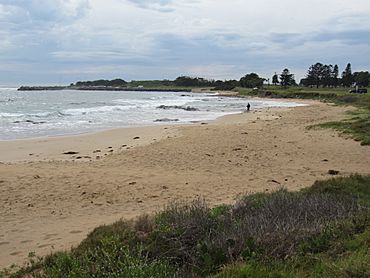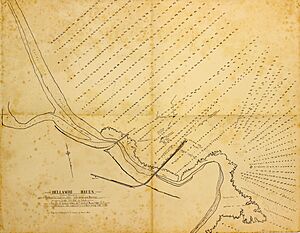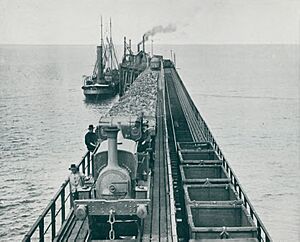Bellambi, New South Wales facts for kids
Quick facts for kids BellambiWollongong, New South Wales |
|||||||||||||||
|---|---|---|---|---|---|---|---|---|---|---|---|---|---|---|---|

Former site of the South Bulli coal jetty on the northern side of Bellambi Point
|
|||||||||||||||
| Population | 4,039 (2021 census) | ||||||||||||||
| Postcode(s) | 2518 | ||||||||||||||
| Elevation | 11 m (36 ft) | ||||||||||||||
| Location |
|
||||||||||||||
| LGA(s) | City of Wollongong | ||||||||||||||
| State electorate(s) | Keira | ||||||||||||||
| Federal Division(s) | Cunningham | ||||||||||||||
|
|||||||||||||||
Bellambi (/bɛlæmbi/) is a suburb located in the city of Wollongong, in the Illawarra region of New South Wales, Australia. It has its own railway station, which opened in 1889, on the NSW TrainLink South Coast Line.
Bellambi is found just north of Corrimal and east of Russell Vale. It is known for Bellambi Beach, which is part of the popular Wollongong to Thirroul Bike Track.
The area is on a flat coastal plain, offering great views of the escarpment to the west. One famous peak you can see is Broker's Nose, which is 440 metres high. To the east, you'll find Bellambi Beach and a creek. South of the creek is Bellambi Harbour (once called Port Bellambi) and Bellambi Point.
The first jetty here was built in 1858. A telegraph line connected Wollongong and Bellambi in 1862. Another jetty was added in 1863, and a new one in Bellambi Bay in 1887. The Bellambi Mines Rescue Station was set up in 1927. Bellambi Public School opened in 1956, and a rock pool was built in 1965.
Contents
Exploring Bellambi Point
Bellambi Point is a special area that includes Bellambi Lagoon Reserve. This protected space has many swamp oaks (casuarina), coastal sclerophyll trees, and saltmarsh plants. There's a small hill about ten metres high that has been fenced off to prevent erosion. This area was once used for sand mining.
The point is home to different types of plants found in dunes and wetlands. It also has some rare plant species. It's an important place for wildlife, with over 50 types of birds, including White Breasted Sea Eagles. A local group has been working since 2003 to care for the bushland here.
Aboriginal History and Culture
Bellambi Point is very important to Indigenous Australians. It still has one of the largest shell middens (ancient piles of shells left by Aboriginal people) in New South Wales. However, much of the evidence of Aboriginal life has been lost or damaged over time. This happened because of building projects like tramways and jetties for coal in the late 1800s. Later, large-scale sand mining and a water treatment plant also changed the area.
Despite these changes, old records give us clues about the rich Aboriginal history of the area. For example, in 1860, workers expanding a coal loading area found four human skulls and two stone hatchets. They also found a strange yellow substance that smelled nice when burned.
By 1862, some Aboriginal people still lived a traditional life near Bellambi Point. There was a campsite near Towrodgi Creek. People also knew that skeletons had been found in the sand-hills, and there was an "Aboriginal cemetery on the sand banks close to Bellambi Lake."
In 1890, a skull and other bones were found in a sand dune at Bellambi Point. The bones looked very old. The teeth were perfect, except for one missing front tooth. This missing tooth was thought to be a sign of an old Aboriginal custom. Young people would have a front tooth removed to show they were part of the community and had special rights.
In 1965, during the building of a water treatment plant, another burial was found. The remains and items were removed, but they have since been returned to the Aboriginal community. In 2012, Bellambi Point was officially named an Aboriginal Place. This means it has legal protection as a culturally important site. Work is still being done to restore the site.
Bellambi's Busy Port History
By the late 1800s, Bellambi had two coal jetties. The South Bulli Jetty was named after the mine and was on Bellambi Beach. The Bellambi Coal Co. Jetty (also called the "Woonoona Jetty") was on a small rocky area just north of the South Bulli Jetty. An even earlier coal jetty was built around 1858 but was only used for a short time.
After a storm damaged the Bellambi Coal Co. Jetty in 1898, all coal was shipped from the South Bulli Jetty.
Coal arrived at the jetty by train from the mines. The jetty had two train tracks: one higher track for full coal wagons and a lower one for empty wagons. There were also two loading chutes. To load coal, one end of a wagon was lifted by a steam ram, tipping the coal into a chute and directly into a ship. In 1909, six coal ships were loaded with 4,500 tons of coal in just 14 hours!
Bellambi was a very risky port for ships. Bellambi Point offered some protection from the south, but its reef stretched 600 metres into the sea, making it dangerous. In 1907, a small steamer called Resolute hit the reef and broke apart while just passing by.
To help ships, an electrically-powered occulting light was put on Bellambi Point in 1913. This light could be seen up to 12.9 kilometres out at sea.
Many 'sixty-milers' (ships that carried coal) were wrecked here. Ships like the Llewellyn (1882), Adinga (1896), and Saxonia (1898) all ran aground on the reef. The last 'sixty-miler' to be wrecked was the s.s. Munmorah in 1949. The court investigating the Munmorah accident was not sure if the light was on when the ship hit the reef. Other ships on longer journeys also got into trouble here.
In total, twelve ships were wrecked at Bellambi between 1859 and 1949. Seven of these ships ran aground on the dangerous reef. You can still see the boiler of the SS Munmorah, the last ship wrecked on the reef in 1949, at low tide.
The South Bulli Jetty was used until 1952. The light that helped ships was turned off on March 1, 1954. The jetty partly fell down in 1955 and was completely taken apart in 1970.
Who Lives in Bellambi?
According to the 2021 census Population, there were 4,039 people living in Bellambi.
- About 8.1% of the people were Aboriginal and Torres Strait Islander.
- Most people (73.1%) were born in Australia. The next largest group (4.0%) was born in England.
- About 80.9% of people spoke only English at home.
- When asked about religion, the most common answers were No Religion (41.2%), Catholic (19.5%), and Anglican (12.8%).






